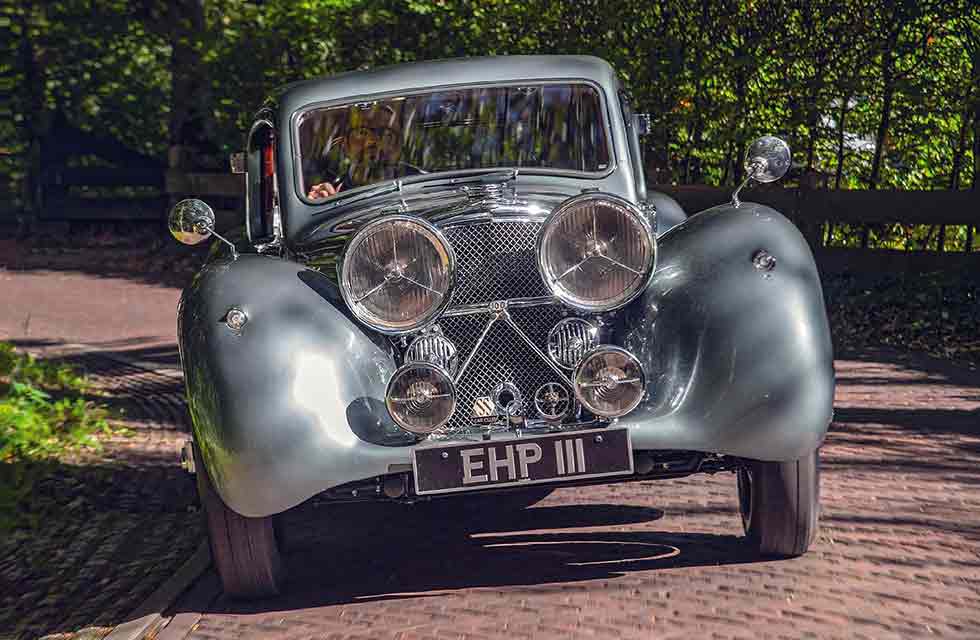
The SS100 Coupé Unique Lyons-styled machine. We get behind the wheel of the only SS coupé built by Jaguar, and styled by Lyons and Cyril Holland. Words: Ian Seabrook. Pics: Matt Richardson.
DRIVEN: UNIQUE SS100 COUPÉ BUILT BY JAGUAR, AND STYLED BY LYONS AND CYRIL HOLLAND
The 1938 Jaguar SS100 Coupé is an important car for several reasons. It is the only closed SS100 built by Jaguar, which makes it a complete one-off. Built for the 1938 Earls Court Motor Show, it was designed to impress. It did just that, selling on the stand. But, it’s the story of how it came to be that is the really important bit. William Lyons had always had a sharp eye for styling, making the leap from sidecars to motor cars with great success. SS was gaining a reputation for style, that had only been reinforced by the rakish SS1 and the pretty SS100 roadster. While others did the crafting, they did so under the beady eye of Lyons, often adjusting and correcting several times until he was happy. The key person in this part of the story is Cyril Holland, who joined SS in Blackpool in 1928. Holland was a master fabricator, but he could also design and sketch. It was his sketch for a rounded, boat-tail body that led to the designing of the first Austin Seven Swallow. As the Lyons/Holland relationship grew, so did the reputation of SS. Perhaps the ultimate pre-war demonstration of this relationship was the new saloon range of 1935. This was easily one of the most beautiful saloons of the era, yet it wasn’t the work of a specialist coachbuilder but the fruit of the Lyons/Holland relationship.
“…for all its exciting history and impact 80 years ago, this car would not lead to the start of SS coupé production.”

The following year, the SS90 and SS100 sports cars joined the range, again displaying beautiful lines that were a cut above most of the competition. But Lyons was fast learning that beautiful show cars could create a real splash at a motor show. For 1938, he planned something special.
He and Holland began work on a sleek coupé, that would naturally follow the same ‘aluminium over ash’ construction as the roadster, but offer something very different. Far more than just being an SS100 with a roof, the car was restyled in pretty much every area. Only the grille was retained. The car was completed and displayed at the 1938 motor show as planned. It was sold to Leo March, and existing SS customer, who gifted the car to his 17-year old son, Gordon. Nicknamed ‘The Grey Lady,’ the SS100 was registered EHP 111. After the Second World War, during which it spent most of the time in storage, the car was sold to a John J Sheehan. By this time, it was sporting a pair of air horns and disc covers for the front wheels, but it was then sold to a film producer, who foisted even worse upon the car. It was repainted in bright red, fitted with XK120-esque bumpers and a radiator mascot.
The fourth owner managed to talk a Police Officer into doing a speed check on EHP. Apparently, the grey lady managed an impressive 105mph. After a spell in the USA, EHP finally came back to England and was restored by noted SS expert David Barber. Finally, EHP was returned to its correct grey. The car then visited Pebble Beach in the late 1980s with another spell of American ownership.
Tom Zwakman and one of his customers took ownership of EHP in 1999. “It was more or less like it is today,” recalls Tom. “We did repair the front springs, and locate them correctly, and carry out some maintenance to the brakes. We also refitted the original engine. It came to us with a MkIV engine, because when it was originally restored, it wasn’t really possible to rebuild these engines. I was very fortunate that SS Restorer David Barber sold me several engines amongst a stock clearance some two decades before we bought the SS. We discovered that the SS coupé’s original engine was amongst this stock, so I had the engine many years before the car. It also still has its original gearbox. We completed a rebuild on the engine, with a full balanced crankshaft, six months ago.”
Yet, for all its exciting history and impact 80 years ago, this car would not lead to the start of SS coupé production. There are several reasons for this, with the Second World War being just one of them. But, 1938 was also a tricky year for SS, with the move to all-steel bodywork on the saloon range. This would have kept Lyons and his team very busy, as many problems were encountered, so now was not the time to be taking on new production headaches. That leaves EHP as an intriguing one-off. It’s time for a closer look.
IN THE METAL
Walking into the Zwakman workshop, the SS Coupe is surrounded by several SSs, an XKSS and an XJR- 15. Hallowed surroundings, and it fits right in. What isn’t clear in photographs is just how petite the car is, being far smaller than similar-era coachbuilt Bentleys or Rolls-Royces.
The front end is dominated by the enormous Lucas headlamps which, combined with the grille, offer perhaps the only clue of the SS100 underpinnings. The flowing, open wings of the SS were replaced by stylish wraparound items, but it is perhaps the roofline that is most pleasing. The way it plunges down and meets the rump of the car is pure Jaguar. It links to the saloon range, and is a styling feature that Jaguar was still trying to replicate with the second S-Type of the 1990s. It’s especially pleasing how the body sweeps up over the rear wheels to meet the roof, giving it something of a lowered hot rod vibe – something you also see with the SS1 coupés. They almost look so extreme as to be Custom Shop created.
There are no running boards, so the front wings elegantly taper to a finish ahead of the doors, while the rear wheels are fully enclosed to ensure a sleek line. The rear aspect of the side view certainly brings the MkVII to mind, but Holland and Lyons also did a good job of converting the flat windscreen into the flowing curve of the roof. The gentle profile also allows a decent amount of headroom.
The rear wings don’t fully blend into the body along their trailing edge, but instead converge into a dainty finishing line that is also very pleasing to the eye. ‘Modern’ 1950s rear lamps are a sensible modification and these standard Lucas lamps don’t look horrendously out of place.
There’s even joy in the way the bootlid unfolds, with a separate compartment beneath it for the spare wheel.
The interior is in stark contrast to the austere SS, something also reflected in the post-war fixed head versions of sports cars. To Lyons, clearly someone who wanted a roof was also after a little comfort and luxury, so there’s a beautiful wood veneer dashboard, similar door cappings and a good dose of leather trim. There’s a small handle to open the windscreen for ventilation, though both door window glasses drop and there’s a pull-back sunroof too. The large steering wheel dominates, and it’s pleasing to see that it isn’t immaculate. It has some sign of use that it has collected over the decades.
Whereas a standard SS has the gearlever hidden beneath the dashboard, the stubby lever falls more readily to hand here. It has a very wide gearknob, while the handbrake sits to the passenger side of the tunnel.
Behind the seats, there are two delightful cubby boxes, one of which has a lift-out tray for oddments. It’s a reminder that carpentry was a key skill at the Foleshill factory when this car was built. There would have been no need to send out for such skills. There’s a good deal of ash under that smooth aluminium-clad exterior, so these interior appointments would have been an amusing distraction.
Under the slide-lifting bonnets is the 3-5-litre Standard-based straight-six, with its Weslake-designed overhead valve arrangement and a pair of carburettors. Zwakman Motors, current custodians of the car, have carried out a complete engine rebuild. They know their way around these engines, and a number of improvements have been made, including far superior crankshaft balancing that allows the engine to rev in a way it never would have back in the day. That said, the engine work was only carried out a few hundred miles ago, so a gentle foot will be required on the throttle. The changes are mostly internal, so to all intents and purposes, it looks pretty much as it should do. We love how both the chassis and engine plates show signs of a great deal of polishing over the years. There is no body number. There doesn’t really need to be for this complete one-off. It all looks wonderfully fresh, and is capped off by a working underbonnet lamp on the nearside.
BEHIND THE WHEEL
Clambering aboard is quite tricky, though aided by the suicide doors. The footwells are not overly-generous in size, and I’m glad I chose sensible shoes that are fairly slim. You almost wear the enormous steering wheel, though I actually find it easier to slide my legs beneath it than say in an XK120. With the door shut, it’s certainly snug and a further reminder of the car’s compact dimensions.
That said, I’m not cramped and can actually stretch my legs out. I try to put myself in the position of an excited 17-year old, taking his first drive almost 80 years ago. The engine fires very promptly into life, and it’s a pleasure to snick the stubby gearlever across and into first gear. As we ease away, I’m mindful to avoid stressing the engine too much, as it is still very much in the running-in phase. Despite that, it pulls well up to our imaginary red line of 3000rpm, making a beautiful, lustful noise as the carburettors drink in the fuel and air. There are no filters to dull the intake roar, but the fact we’re in a closed coupé means the noise isn’t over-bearing. Just very pleasant.
The car steers very well, which is a credit to the work done on the front suspension. Sure, it doesn’t have the poise of independent front suspension, but as we thread our way through the streets of Alkmaar in The Netherlands, it feels very manageable. There are some nerves here, as I contemplate modern traffic from the wheel of this priceless gem, but the brakes offer reassuring power when called upon. Over-the-shoulder visibility is not that good with those broad body sides and small rear window, but the wing-top mirrors help.
The ride isn’t bad at all for the simple beam axle suspension design, but what really surprises is the transmission. It’s an absolute delight, whether going up or down the gears. No crunching, no unpleasant noises, just a tight feel that allows you feel the mechanical precision at work and a beautiful whine as you ease away in first gear. In fact, so confident am I with this transmission that I risk a double-declutch into first gear as we pass through a rather congested town centre. The gearlever slots in perfectly.
While we naturally couldn’t test the outright performance of this car, nonetheless it was able to prove entertainingly brisk through the gears. By 1930s standards, this really is a quick car, able to top 100mph with no problem. As it’s heavier than the roadster, we suspect the acceleration is a little slower, but it feels lively in a way most 1930s cars do not.
Being behind the wheel isn’t so much about how the car drives though, it’s an experience to be savoured – driving an 80-year old beauty with so much history behind it. Naturally, it garners plenty of attention on the road, but how many passers-by know just how special this car is? It isn’t just the fact that it’s a oneoff show car. It’s the way, for me at least, that it seems to bridge the gap between the pre- and post-war sports cars. It seems remarkable that it would be another 13 years before Jaguar built another fixed-head sports car, but the DNA is clear to see here.
Also, the car was built largely because Jaguar had no new cars to launch in 1938. That Lyons knew that a sleek sports car would be a great way to generate attention must surely have affected the decision to build the XK120 show car, and that was a vehicle that definitely would not remain a one-off.
So, while this car would ultimately be seen as a dead-end, it certainly was not a wrong turning. This is one birthday girl who remains very special indeed.
“Being behind the wheel isn’t so much about how the car drives though, it’s an experience to be savoured”
Sleek body allowed the SS100 to easily top 100mph. This angle shows off the beautiful lines very nicely. The SS100 has been reunited with its original engine. The way the roofline plunges down to the rear is pure Jaguar. Original built-in lamps replaced by 1950s Lucas units. Well-polished original plates. Huge drum brakes offer surprisingly efficient braking. Only remaining SS body features are the grille and enormous Lucas lamps. Stubby gearlever falls nicely to hand. Beautiful interior is in superb condition, and very cosy. 4500rpm red line is a sign of the times. Windscreen opens for ventilation (above) while behind the seats is an intricate stowage area.
“The front end is dominated by the enormous Lucas headlamps which, combined with the grille, offer perhaps the only clue of the SS100 underpinnings”









